Roman Britain › Roman Gaul » Ancient origins
Articles and Definitions › Contents
- Roman Britain › Ancient History
- Roman Gaul › Antique Origins
Ancient civilizations › Historical and archaeological sites
Roman Britain › Ancient History
Definition and Origins

Britain was a significant addition to the ever-expanding Roman Empire. For decades Rome had been conquering the Mediterranean Sea - defeating Carthage in the Punic Wars, overwhelming Macedon and Greece, and finally marching into Syria and Egypt. At long last, they gazed northward across the Alps towards Gaul and ultimately setting their sights across the channel (they believed it to be an ocean) into Britannia. After Claudius ' invasion in 43 CE, part of the island became a Roman province in name, however, conquest was a long process. Constantly rebellious and twice reorganized, it was finally abandoned by the Romans in 410 CE.
BRITAIN BEFORE ROME
At the time of the Roman arrival, Britain (originally known as Albion) was mostly comprised of small Iron Age communities, primarily agrarian, tribal, with enclosed settlements. Southern Britain shared their culture with northern Gaul (modern day France and Belgium); many southern Britons were Belgae in origin and shared a common language with them. In fact, after 120 BCE trading between Transalpine Gaul intensified with the Britons receiving such domestic imports as wine; there was also some evidence of Gallo-Belgae coinage.
CAESAR 'S CAMPAIGN
Although Julius Caesar ’s presence did not result in conquest, it was this intense trade - some claim it was partly ego - that brought the Roman commander across the Channel in both 55 and 54 BCE. Previously, the Channel, or Mare Britannicum, had always served as a natural border between the European mainland and the islands. During his subjugation of Gaul during the Gallic Wars, Caesar had wanted to interrupt Belgae trade routes; he also assumed the Britons were assisting their kindred Belgae. Later, he would rationalize his invasion of Britain by telling the Roman Senate that he believed the island was rich in silver. Although the Republic was probably aware of the island's existence, Britain, for the most part, was completely unknown to Rome, and to many more superstitious citizens, only existed in fables; traders repeatedly told of the islanders' barbarous practices. To the disgust of many Romans, they even drank milk.

Map of the British Isles in 54 BC
Nevertheless, Caesar's initial contact with the islanders went poorly, and he had to quickly reorganize his army to avoid defeat.During his second 'invasion' when he was accompanied by five legions, he pushed further northward across the Thames River to meet the Briton chieftain Cassivellaunus. Although he was joined for battle by several local chieftains, to avoid crossing the Channel in poor weather, Caesar feigned growing problems in Gaul, arranged a peace treaty with Cassivellaunus, and returned to the European mainland without leaving a garrison. While many Romans were enthusiastic about Caesar's excursion across the Channel, Caesar's worst enemy Cato was aghast. The Greek historian Strabo, a contemporary of the late Republic, said the only things of value were hunting dogs and slaves. More important to Caesar was the difficulties developing in Gaul, a failed harvest, and possible rebellion. The Romans would not return to Britain for another century.
CLAUDIUS' INVASION
With the death of Caesar and the civil war that followed, the Republic was no more, and the new empire ’s interest in Britannia intensified under both Emperors Augustus and Caligula as the Romanization of Gaul progressed. While Augustus's attentions were drawn elsewhere, Caligula and his army stared across the Channel towards the British Isles - the emperor only ordered his men to throw their javelins at the sea - there would be no invasion. The actual annexation fell to the most unlikely of emperors, Claudius (41 – 54 CE).
In 43 CE, Emperor Claudius with an army of four legions and auxiliaries under the command of Aulus Plautius crossed the English Channel, landing at Richborough. They began the conquest of the island. Some believe the emperor's only goal was personal glory; years of humiliation under Caligula left him longing for recognition. Although he had only been there sixteen days, Claudius would take credit, of course, for the conquest with a glorious triumphant return to Rome in 44 CE.

Claudius as Jupiter
The Roman army had landed on the British shore and marched northward towards the Thames River; it was there that Claudius joined them. Rome's army quickly overran the territory of the Catuvellauni with a victory at Camulodunum (modern-day Colchester). Afterwards, the army quickly moved to the north and west, and by 60 CE much of Wales and the areas to the south of Trent were occupied. Client kingdoms were soon established including the Iceni at Norfolk and the Brigantes to the north. While one legion was sent northward, the future emperor Vespasian led another legion southwest where he would capture 20 tribal strongholds. Cities such as London (Londinium) - because of its proximity to the Channel - and St. Albans (Verulamium) were established.
REVOLTS & CONSOLIDATION
There was, however, considerably resistance; the Britons were not about to quit without a fight. Caratacus, a member of the Catuvellauni, rallied considerably support in Wales only to be captured in 51 CE. After his defeat, he escaped and made his way to a region controlled by Brigantes whose queen quickly turned him over to the Romans. He and his family were taken to Rome in chains. In Rome, a triumph was held to glorify Claudius, but the captured chieftain was given the opportunity to speak to the Roman people:
Had my lineage and rank been accompanied by only moderate success, I should have come to this city as friend rather than prisoner, and you would not have disdained to ally yourself peacefully with one so nobly born … If I had surrendered without a blow before being brought before you, neither my downfall nor your triumph would have become famous. If you execute me, they will be forgotten. Spare me, and I shall be an everlasting token of your mercy. (Tacitus, Annals, 267)
His life, together with that of his wife, daughter, and brothers, was spared by Claudius.
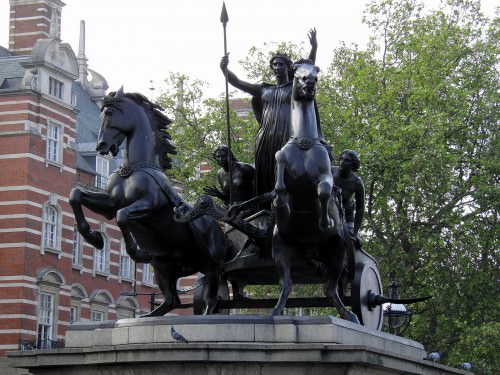
Queen Boudica
While Caratacus's revolt was a failure, Rome had yet to tangle with the mighty Boudica. She was the wife of Prasutagus, a Roman ally and client king of the Iceni, a tribe in eastern Britain. His death in 60/61 CE left a will that gave one-half of his territory to Rome and one-half to his daughters; however, Rome did not wish to share the kingdom and, instead, decided to plunder it all. The result left Boudica flogged and her daughters raped. Although she and her army would eventually be defeated, she rose up, gathered an army, and with the neighboring Trinovantes went on the offensive. Towns were sacked and burned, including Londinium, and residents killed - possibly as many as 70,000 (these are Roman numbers and may or may not be completely accurate). In his Annals Tacitus wrote,
Boudicca drove around all the tribes in a chariot with her daughters in front of her. "We British are used to woman commanders in war." she cried. "I am descended from mighty men! But now I am not fighting for my kingdom and wealth. I am fighting as an ordinary person for my lost freedom, my bruised body, and my outraged daughters." (330)
She prayed that the gods would grant her the vengeance the British deserved. Unfortunately, her prayers went unanswered, and instead of surrendering to the Romans, she committed suicide. Tacitus believed that had it not been for the quick response of Roman governor Gaius Suetonius Paulinus, Britain would have been lost.
ROMANIZATION
ALTHOUGH PROGRESS WAS RELATIVELY SLOW, ROME CONSIDERED THE CONQUEST OF BRITAIN NECESSARY.WHILE JULIUS CAESAR HAD DISMISSED THE ISLAND AS HAVING LITTLE OF VALUE, THE TRUTH WAS FAR FROM IT.
The Battle of Watling Street was the last serious threat to Roman authority in the lowlands. Aside from his victory against Boudicca, in his desire to strengthen Roman presence, Paulinus also eliminated the Druid stronghold at Anglesey; the Druid religion had always been considered a threat to the Romans and their imperial cult. Accordingly, the governor's rather vigorous response to the Boudica's surrender led not only to his recall by Rome - he was replaced by Turpilianus - but a change in Roman policy towards Britain. Gradually, Britons were adopting Roman ways. With a stronger presence in Britain, Rome began to make significant changes. Burnt towns were rebuilt. Soon, London (Londinium), serving as the administrative capital, would have a basilica, a forum, a governor's palace, and a bridge crossing the Thames.
Although progress was relatively slow, Rome considered the conquest of Britain necessary. While Julius Caesar had dismissed the island as having little of value, the truth was far from it. Not only was it important for its tax revenue but it was also useful for its mineral resources - tin, iron, and gold and as predicted hunting dogs and animal furs. Mining developed. In addition, there was its grain, cattle, and, of course, slaves. Roads were built; Watling Street which linked Canterbury to Wroxeter on the Welsh border and Ermine Street which ran between London and York. And, with any burgeoning economy, merchants arrived, resulting in increased trade and commerce. However, despite the presence of a strong military, resistance continued, so expansion remained gradual.
AGRICOLA'S CAMPAIGN
From 77 to 83 CE the military commander Gnaeus Julius Agricola - ironically the father-in-law of Tacitus - served as governor.It was not Agricola's first time In Britain. He had served there as a young man on Suetonius Paulinus' staff as a military tribune. In his On Britain and Germany, the historian wrote about Agricola's previous stay in Britain stating that he was energetic but never careless. Concerning the state of affairs in Britain at the time, he wrote, "Neither before nor since has Britain ever been in a more uneasy or dangerous state. Veterans were butchered, colonies burned to the ground, armies isolated. We had to fight for life before we could think of victory" (55). The Britons were on the defensive. "We have country, wives and parents to fight for: the Romans have nothing but greed and self-indulgence" (65).

Agricola's campaigns
The tribune studied his craft well, and in his return to the island as governor, he was prepared. His first order of business was to restructure the army's loose discipline and reduce abuses, thereby giving men a reason to "love and honor peace." With his new army, he marched northward to Caledonia ( Scotland ) conquering much of northern England along the way.
In a series of conflicts, Agricola was able to achieve victory, subduing northern Wales and finally meeting the Caledonians at Mons Graupius. The governor even eyed the neighboring island of Ireland, claiming it could be taken with only one legion.Unfortunately, Agricola was forced to withdraw from Scotland when one of his legions was recalled by Emperor Domitian (81 - 96 CE) to confront intruders along the Danube. However, despite his attacks against rebels, Agricola was not a cruel conqueror. Aside from the forts he built to the north, he fostered 'civilizing' or Romanizing the Britons, encouraged urbanization, moving into towns that were equipped with theaters, forums, and baths. And, like other conquered lands, Latin was to be taught.
HADRIAN 'S WALL & THE ANTONINE WALL
Unfortunately, his success would not go unnoticed by Domitian, who, in a fit of jealousy, recalled Agricola. The territory he had long desired to the north, Scotland, would not be fully conquered for years to come. Eventually, a 73 mile (118 km) long stone and turf wall would be built between the province of Britain and barbarian territories under Emperor Hadrian (117–138 CE).The emperor had visited both Gaul and Britain in 121 and 122 CE and believed that in order to maintain peace the frontier had to be secured. He realized that external expansion meant an increased reliance on strengthening frontier defenses. Although taking years to build and manned with 15,000 soldiers, it seems that it was not to keep the barbarians out but designed solely for surveillance and patrols.
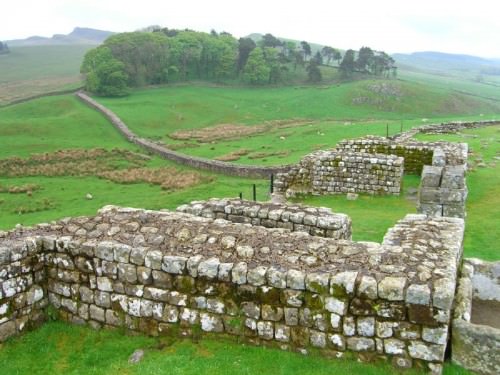
Hadrian's Wall Gate
By 130 CE military garrisons had been established throughout Britain. It was at this time that Rome realized the need to further strengthen their army on the European continent and began to recruit from the 'barbaric' provinces of the empire, namely the Balkans and Britain.
In 139 CE another wall, the 37 mile (60 km) long Antonine Wall (named for the Emperor Antonius Pius), was built c. 100 km to the north between the Firth of Forth and the River Clyde; however, it was too difficult to defend, and therefore it was abandoned in 163 CE.
3RD-4TH-CENTURY DEVELOPMENTS
Further changes soon came to the island. In order to rule more efficiently, the island was divided in half, Britannia Superior governed from London, and Britannia Inferior governed from York (Eboracum). Emperor Diocletian would later divide the province into four separate regions. Because of Diocletian's tetrarchy, Britain was then placed under the watchful eye of the emperor in the west.

Coins of Carausius
Trouble continued to haunt Britain. During the 3rd century CE, the island had been under constant attack by the Picts of Scotland, the Scots from Ireland, and the Saxons from Germany. After a rebellion led by Carausius and then Allectus enabled Britain temporarily to become a separate kingdom, the Roman emperor of the west Constantius (293 – 306 CE) regained control in 296 CE. The emperor had served as a military tribune combatting Celtic tribes earlier in his career. In celebration of his victory, he received a much-deserved title from the people of London 'The Restorer of the Eternal Light.'
ABANDONMENT & AFTERMATH
However, along with the arrival of Christianity, by the end of the 4th century CE, Rome was having trouble maintaining control of Britain. After Alaric ’s sack of Rome in 410 CE, the western half of the empire began to undergo significant changes;Spain, Britain, and the better part of Gaul would soon be lost. The eastern half of the empire, based in Constantinople, became the economic and cultural center. The loss of the rich grain-producing provinces doomed Rome. According to historian Peter Heather in his The Fall of the Roman Empire, Britain, unlike other provinces, was more prone for a revolt or break with Rome because many civilians, as well as military personnel, felt left out; attention (primarily defense) was being given elsewhere. Emperor Valentinian I (364-375 CE), who had defeated Saxon insurgents in 367 CE, gradually began to withdraw troops. In 410 CE Honorius, one of the last emperors of the west, pulled out completely; the emperor even wrote letters to individual British cities informing them that they were to 'fend' for themselves. In the final days, Roman magistrates were expelled and local governments were established.
Britain was no longer a province of Rome; however, the years that followed could not erase all of the empire's impact on the people and culture of the island. There was occasional contact with Rome. Missionaries helped Christians battle the heretics, and in the 5th century CE, as attacks from Saxons increased and marauders from Ireland and Scotland raided the English coast, an appeal went out to the Roman commanding general Aetius for help. He never replied. As Europe fell under the veil of the 'Dark Ages,' Britain would break into smaller kingdoms. The Vikings would cross the sea in the late 8th century and cause havoc for decades. Finally, one man would ward off the Viking attempt at conquest and claim to be king of England, Alfred the Great. Britain would recover.
Roman Gaul › Antique Origins
Definition and Origins
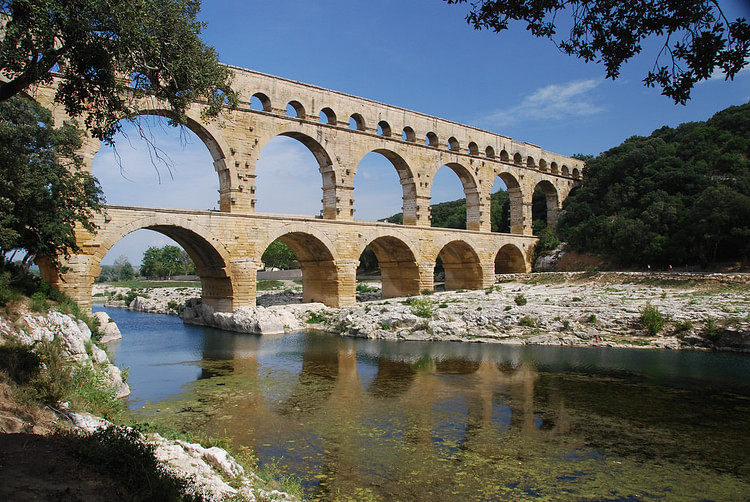
Roman Gaul is an umbrella term for several Roman provinces in western Europe :
Cisalpine Gaul or Gallia Cisalpina, comprised a territory situated in the northernmost part of the Italian peninsula ranging from the Apennines in the west northward to the Alps, specifically the plains of the Po River. It was an area that most Romans did not consider to be part of Italy ; to them, Italy only extended to the foothills of the Apennines. The territory was conquered following the capture of Mediolanum (Milan) in 222 BCE, however, it was not until the Social War that the established colonies were organized into a province.
Further north, across the Alps, was Transalpine Gaul or Gallia Transalpina. It spread from the Pyrenees, a mountainous range along the northern border of Roman-controlled Spain, northward to the English Channel - much of modern-day France and Belgium. As the home to a number of Celtic people, many Roman citizens viewed the area with fear and wonder; it was a land of barbarians. The area to the far south from the Mediterranean Sea to Lake Geneva - the closest to Roman Spain (land acquired in the Punic Wars ) - had been formed into a province in 121 BCE. In 58 BCE, the future dictator-for-life Julius Caesar would march into Transalpine Gaul, subjugating the whole territory after a decade-long campaign.
A LAND OF BARBARIANS
While the Romans were busy displacing a king and building a republic, a number of tribes of Celtic people, who were said to have a warrior aristocracy, migrated across the Alps into the Po Valley. While historical descriptions are scant ( Livy wrote briefly of it), archaeological accounts verify the arrival of a number of these tribes: the Insubres in the 6th century BCE, the Cenomani, Boii, Lingones, and lastly the Senones in the 5th and 4th centuries BCE. By the end of the 4th century BCE, while making occasional raids across the Apennines into Italy, the Celts completely displaced the Etruscans of Etruria, a small territory located in central Italy, north of Rome. Etruria turned to Rome for help. Unfortunately, Rome's response would bring unrest to the small emerging republic.
AS THE HOME TO A NUMBER OF CELTIC PEOPLE, MANY ROMAN CITIZENS VIEWED THE AREA WITH FEAR & WONDER; IT WAS A LAND OF BARBARIANS.
From the founding of the Republic through the 3rd century BCE, while the city ’s government coped with a number of internal political issues, Rome had grown to become a principal power on the Italian peninsula, so it was natural for the Etruscans to appeal to the city for help against the invading Celts. Around 386 BCE (dates vary), the Celts pushed through Etruria and into the heart of the unwalled city of Rome. However, this raid on Rome was not completely without provocation. 15,000 men - Rome's entire army - were sent to face an army twice its number. Sending a small delegation to meet the Celts, Rome hoped for a peaceful solution. Unfortunately, a Celtic delegate was killed by a Roman. In retaliation, the now defenseless Rome was sacked.
According to ancient sources (Roman of course), people quickly fled the city as the last defenders fought heroically, eventually seeking refuge on Capitoline Hill. Senators were butchered where they stood. Forced to pay tribute, the city was torched.There were many who wanted to completely abandon Rome and move to Veii, a city to the northwest, but wiser heads prevailed. Under the leadership of Marcus Furius Camillus, who had assumed the position of dictator, the city was quickly rebuilt. The Celtic raids would continue until the Romans prevailed at the Battle of Telamon in 225 BCE. The destruction, however, had a two-fold effect on the citizens of Rome: the incentive to build the Servian Wall and an intense loathing for the Celts and Gaul, a hatred Julius Caesar would later use as a ploy for his invasion.
THE FIRST ROMAN COLONIES
From Telamon, the confident Romans, together with their allies, advanced into Cisalpine Gaul in a three-year campaign capturing Mediolanum (Milan) in 222 BCE. In 218 BCE, Roman colonies were established at Placentia and Cremona on the banks of the Po River. Unfortunately, further advancement was halted during the Second Punic War (218-201 BCE) when Hannibal Barca and his army of 30,000 infantry, 9,000 cavalry, and 37 elephants crossed the Alps, advancing towards Rome.His invasion prompted many of the newly conquered Celts to join him; however, following the defeat of Carthage at Zama in 202 BCE, the Romans would resume their attack against Cisalpine Gaul, ending with the both the massacre of the fiercest of all Gallic tribes, the Boii, in 191 BCE and the rebuilding of Placentia and Cremona. Other colonies were soon built at Bononia, Parma, and Mutina. Gradually, after the Social War in the early 1st century BCE, residents from the southern peninsula began to move into the area. Although much of the Gallic culture would remain, Romanization had begun. Cisalpine Gaul would soon become a Roman province with its southern border extending to the Rubicon.
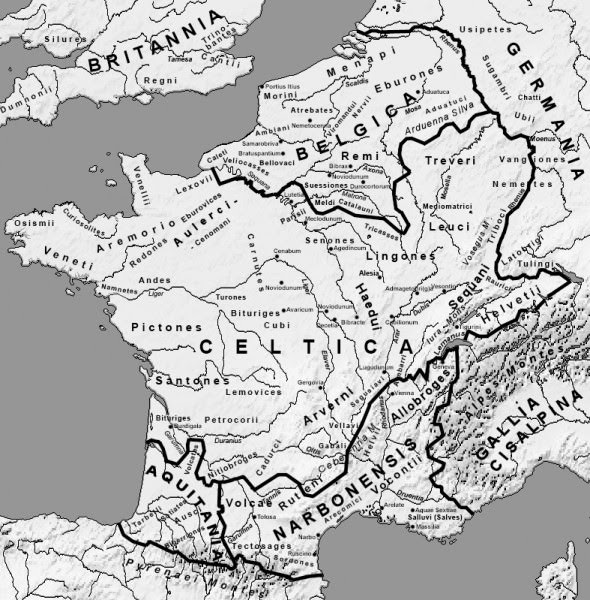
Map of Gaul
From the relative safety behind the walls of Rome, its citizens looked across the Alps into Transalpine Gaul, the vast region from the Pyrenees northward to the English Channel. After Julius Caesar returned from his decade-long subjugation in 49 BCE, the entire area would become Roman. His adopted son and heir, Emperor Augustus, would divide the vast territory into four provinces: Narbonensis in the southeast, Lugdunensis lying just north of the Pyrenees, Aquitania in the center and to the north, and Belgica - present-day Belgium. Although mostly Celtic in culture, Transalpine Gaul included several native tribes: Ligurians and Iberians to the south (an area heavily influenced by Greek colonization ) and Germans to the northeast. Not all of the territory was alien to Rome. The area to the far south from the Mediterranean Sea to Lake Geneva - the closest to Roman Spain (land acquired in the Punic Wars) - had been formed into a province in 121 BCE with its capital at Narbo. It would become the province of Gallia Narbonensis. This area, especially the city of Massalia, had served as a corridor for trade and travel from Spain to the Italian peninsula and Rome.
Still, much of Gaul was fairly unknown to Rome and simply labeled Gallia Comata or long-haired Gaul. In the opinions of many Romans, all of Gaul was barbaric, but, of course, most Romans saw anyone who was not Roman to be a barbarian. Oddly, when Julius Caesar arrived, he did not find a land of barbarians. While there may have been few roads and no aqueducts, there were walled urban or administrative centers called oppida, built on hills for easy defense. Needless to say, these centers were unlike the cities one would find in other Roman territories; there were no public baths, forums, or gladiatorial contests.The people of Gaul were excellent metalworkers, great horsemen, and skilled mariners. However, everything was soon to change, for Gaul would never experience anything like Julius Caesar again. For ten long years, the future dictator would march across Gaul earning himself both fame and fortune, returning to Rome a conquering hero.
CAESAR & THE GALLIC WAR
After his one-year term as consul had ended, he was appointed the governor - on Pompey ’s urging - of Cisalpine Gaul, Illyricum, and Transalpine Gaul. In 58 BCE Julius Caesar and his army crossed the Alps into Transalpine Gaul on a five-year campaign; it would be extended for another five years in 56 BCE. Caesar had alienated many in the Senate during his year as consul, especially his archenemy Marcus Porcius Cato (Cato the Younger). The Roman Senate conservatives who had no love for Caesar had hoped he would serve quietly in Rome after his consulship, but he chose otherwise. During his long campaign through Gaul, he would write a series of dispatches to the Senate. Written in the third person, these dispatches would become his Commentaries on the Gallic War. In the opinion of many of his contemporaries and later historians of the period, they were an attempt to rationalize his abuses, demonstrating his talents as a general and his role as a loyal servant of the Republic.
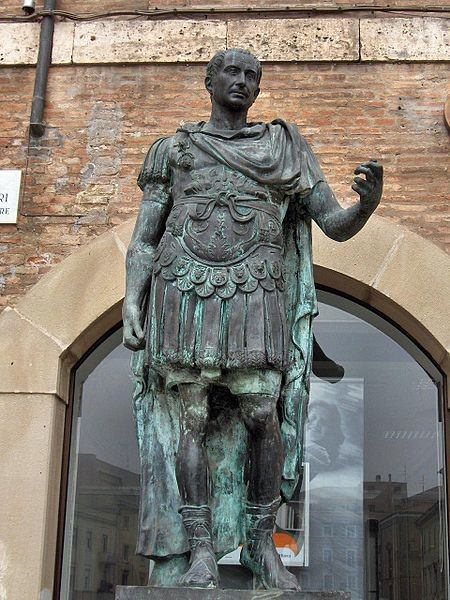
Julius Caesar
Despite his support from the Roman people and a few in the Senate, there were others who believed he only wanted to justify his brutal tactics. In an appeal to the people, he reminded them of the savagery of the Gallic people and their invasion and sacking of Rome decades earlier. The historian Suetonius wrote in his The Twelve Caesars about a number of discussions held in the Senate while he was in Gaul. Caesar may have been disliked by many in the Senate but the people loved him.Suetonius wrote,
…some speakers went so far as to recommend that Caesar should be handed over to the enemy. But the more successful his campaigns, the more frequent the public thanksgivings voted; and the holidays that went with them were longer than any general before him had ever earned. (19)
Whatever the Senate may have believed, Caesar had a good reason - at least in his mind - to advance into Gaul. The Helvetii, a Gallic tribe from southern Germany, were planning to migrate into eastern Gaul, a plan that would threaten the safety of the region. The Helvetii marched through land occupied by the Aedui who wisely appealed to Caesar for aid. Quick to act, Caesar and his army defeated the Helvetii at the Battle of Bibracte in 58 BCE, forcing them to retreat.
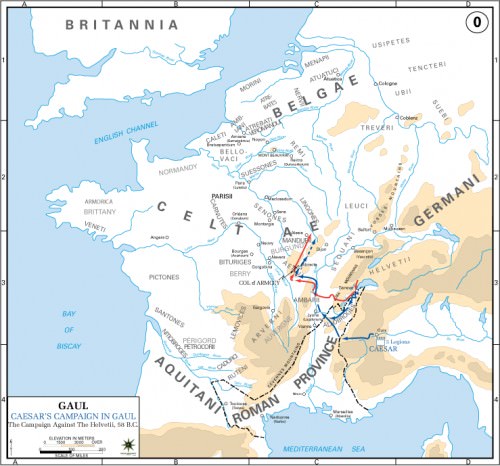
Caesar's Campaign against the Helvetii
At first, many of the Gallic tribes welcomed Caesar; however, they soon realized that the Romans were not rescuers but there to stay; their warm greeting was soon replaced by a cold shoulder. Tribe after tribe fell to the Romans. As the dispatches reached Rome, people eagerly began to follow Caesar's exploits. The Senate could no longer object, although many still believed his conquest to be nothing more than genocide. Caesar continued across Gaul with little opposition, exploiting the rivalries among the various tribes. He defeated the Germanic king Ariovistus, routed the Germans at Alsace, marched against the Belgae in 57 BCE, and crushed the Veneti of Brittany. In 55 BCE, he looked across the English Channel and chose to invade Britain. Initially, Caesar said he wanted to interrupt Belgae trade routes, but some maintain it was his ego that brought the commander across the Channel in both 55 and 54 BCE. Nevertheless, Caesar's initial contact with the Britons went poorly.In his second invasion, he pushed northward across the Thames River but soon feigned growing problems in Gaul and returned to the European mainland.
ROMANIZATION
In 52 BCE, under the leadership of Vercingetorix, the once loyal Arverni challenged Caesar, eventually defeating him at Gergovia. The king's victory was due to a number of old-fashioned maneuvers: the scorched-earth policy, basic guerilla tactics, and a simple knowledge of the terrain. Later in the same year, the two armies would meet again at Alesia with different results.As the king sat behind the well-fortified walls of the city, Caesar and his army waited patiently outside, planning to starve the Gauls out. With his reinforcements defeated by Caesar, Vercingetorix had little choice but to surrender. Many of the defeated Arverni soldiers were sold into slavery. The beaten king would spend the remainder of his life in Rome as a prisoner only to be put to death in 46 BCE.
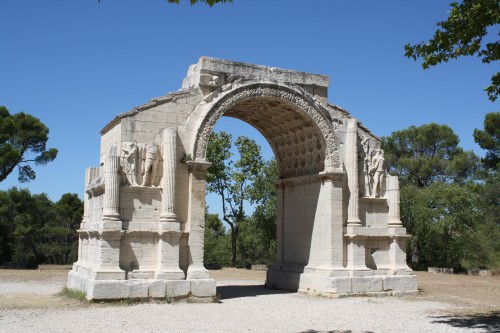
Monumental Arch, Glanum
This final victory spelled the end of the Gallic War in which over 1,000,000 were killed or enslaved. Caesar proudly announced that Gaul had been pacified. With Caesar returning to Rome, Romanization of Transalpine Gaul began, Latin was introduced, and many of the old settlements in Gaul were abandoned with new towns of 'brick and stone' being built, something that made for easy access and not for defense. These new cities were very Roman with bath houses, temples, and amphitheaters.Veterans of the war were granted land which caused agriculture to flourish, much appreciated by a growing Rome. New roads were built allowing for increased commerce. Although there was the occasional rebellion - one in 21 CE led by the Treveri and Aedui, and another in 69-70 CE led by the Batavian Julius Civilis - Gaul would demonstrate little resistance. However, while stability reigned for several decades in Gaul, chaos soon disrupted the peace and quiet.
POSTUMUS & THE GALLIC EMPIRE
The 3rd century CE brought disorder; the Alemanni raided Gaul and Italy while the Franks moved into Spain, destroying Tarraco. The Pax Romana - Roman Peace - was gone. Emperor after emperor rose to power through the military only to fall victim to his own troops. In a fifty-year period from 235 to 285 CE, there were at least twenty emperors with the majority either dying in battle or through assassination. In 260 CE, a military commander and governor of Germania Inferior and Germania Superior (Lower and Upper Germany) Marcus Cassianius Latinius Postumus (whose family was Gallic in origin) rose up against the Roman emperor Gallienus, seizing power, killing the emperor's son and protector, and establishing himself as the new emperor in Gaul, Britain, and Spain; Spain would later rebel and rejoin Rome.
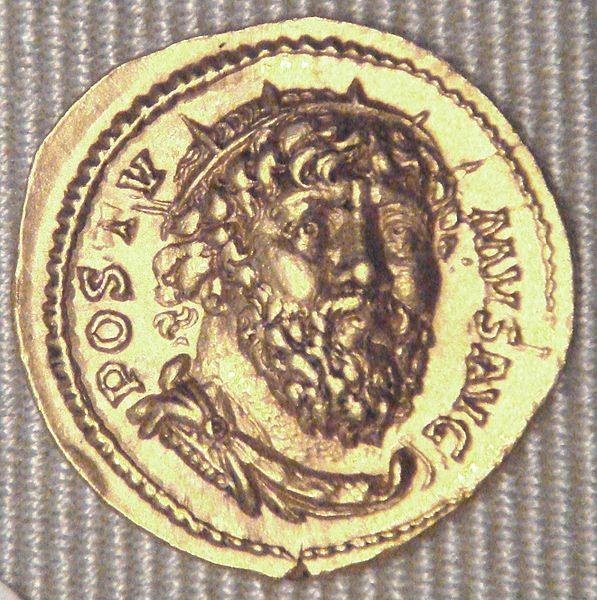
Coin Depicting Roman Emperor Postumus
Although Gallienus marched against Postumus, direct conflict was eventually aborted. While Postumus was opposed by imperial forces and suffered defeat, he and Gallienus would never meet in serious battle. The emperor was forced to withdraw, having received a serious wound. Afterwards, the new emperor of the so-called Gallic Empire would establish his capital and residence at Augusta Treverorum complete with a senate. Surprisingly, he made no attempt to march on Rome. The new empire (260 – 274 CE) would last through four emperors: Laelianus, Marius, Victorinus, and Tetricus. In 269 CE, Roman Emperor Claudius II sent a small expeditionary force against Victorinus but chose not pursue a full confrontation. In 274 CE, Emperor Tetricus and his son marched against Roman Emperor Aurelian at Chalons-sur-Marne and were defeated. Gaul and Britain were reunited with Rome.
FALL OF THE ROMAN EMPIRE
However, the next few years proved to be no better for Gaul. Emperor Probus (276 to 282 CE) saw devastation in both Gaul and the Rhineland by the Franks, Vandals, and Burgundians. It would take over two years to restore order. Two decades later the area would fall under the leadership of the future emperor in the East, Constantine. With his death in 337 CE, his eldest son Constantine II received control of Gaul, Britain, and Spain. Upon his death at Aquileia, his brother Constans took sole leadership only to fall to a palace conspiracy and yield the throne to his brother Constantius II in 353 CE. He eventually divided his power with his cousin Julian the Apostate. In 406 CE, Vandals were among many 'barbaric' tribes to cross the Rhine and ravage Gaul. Visigoths were next, and then there was Attila the Hun. By the fall of the western half of the empire in 476 CE, Gaul had already fallen into the hands of the Franks, Burgundians, and Visigoths.
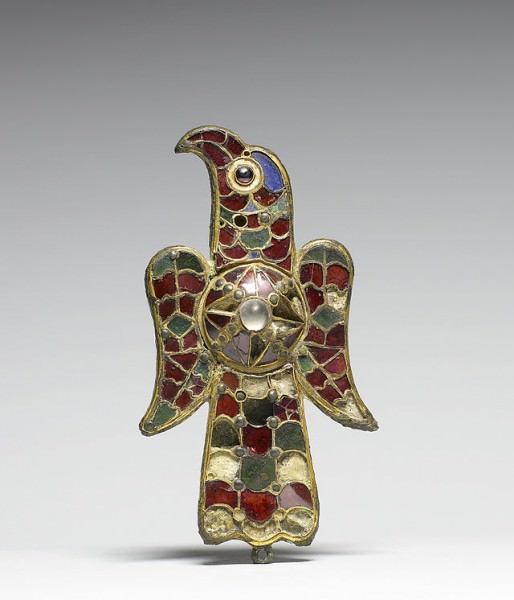
Visigothic Fibula
Both Cisalpine and Transalpine Gaul proved to be of great value to both the Republic and the Empire, providing agricultural goods and soldiers for the Roman army. Unfortunately, over time, Rome was unable to maintain its borders against invasions from the north and east. By this time, like the rest of the empire, Christianity was flourishing, becoming the recognized religion of the empire. The fragile economy of the western half of the empire was in serious decline - Rome was no longer the city it once had been, even the emperor would not live there. The empire's economic and cultural dominance was in the east at Constantinople. Eventually, Gaul, Spain, and the other provinces in the west fell to a number of invading tribes, the Franks, the Burgundians, the Vandals, and Visigoths. In 476 CE Rome was sacked and the empire, at least in the west, was no more.
POST-ROMAN GAUL
Roman Gaul became Visigothic Gaul until Clovis came to the throne as king of the Franks in 481 CE. Clovis would eventually drive the Visigoths into Spain, defeat the Burgundians and Alemanni, and thereby consolidate all of Gaul. In November 511 CE, Clovis died leaving a kingdom to his sons, which was a combination of Roman and Germanic culture, language, religion, and law. By the time of his death, he had extended his authority from the north and west, southward to the Pyrenees. He is considered by many to be of both the founder of Merovingians dynasty and France.
LICENSE:
Article based on information obtained from these sources:with permission from the Website Ancient History Encyclopedia
Content is available under License Creative Commons: Attribution-NonCommercial-ShareAlike 3.0 Unported. CC-BY-NC-SA License